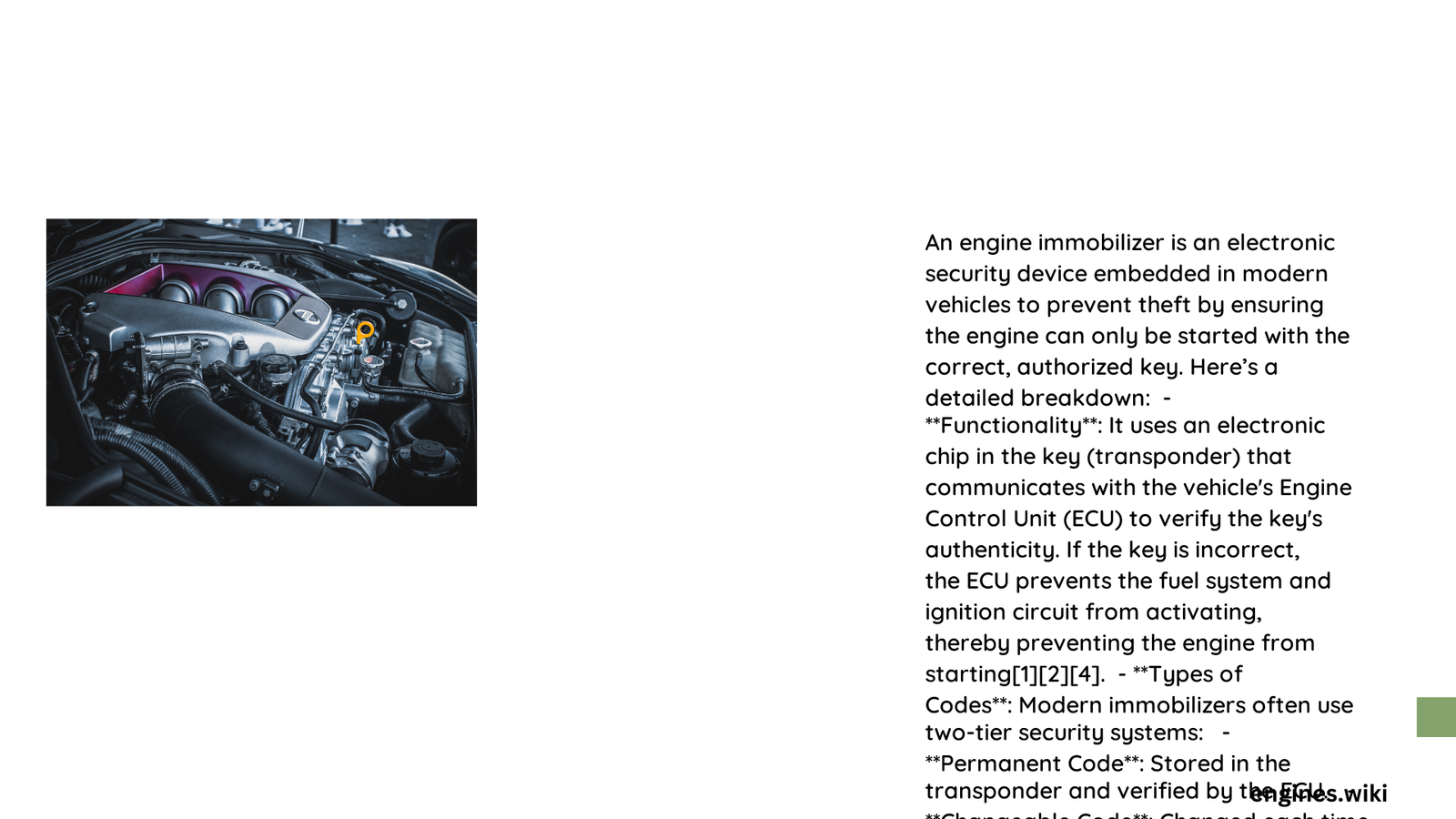An engine immobilizer is a sophisticated electronic security system designed to prevent unauthorized vehicle access and theft by blocking engine start attempts without the correct key or electronic signal. This advanced technology integrates directly with a vehicle’s Engine Control Unit (ECU), using transponder chips and radio frequency identification (RFID) to create a robust anti-theft mechanism that significantly reduces the risk of vehicle theft.
What Exactly is an Engine Immobilizer?
An engine immobilizer represents a critical automotive security technology that prevents unauthorized vehicle operation. Unlike traditional mechanical locks, this electronic system provides a sophisticated layer of protection by electronically verifying the authenticity of the vehicle’s key before allowing engine activation.
How Does an Engine Immobilizer Work?
| Component | Function | Security Mechanism |
|---|---|---|
| Transponder Key | Transmits Unique Code | Encrypted Electronic Signal |
| ECU | Validates Key Code | Compares Received Signal |
| Fuel System | Activation Control | Blocks Fuel Pump/Ignition |
Key Technical Characteristics
- Instantaneous Authentication: Verifies key within milliseconds
- Rolling Code Technology: Generates dynamic security codes
- Encrypted Communication: Prevents signal replication
- Automatic Activation: No manual intervention required
What Makes Engine Immobilizers Effective?
Engine immobilizers leverage advanced cryptographic techniques to create an almost impenetrable barrier against vehicle theft. The system operates through these primary mechanisms:
- Code Generation
- Unique electronic signature created for each key
- Randomized code sequence prevents predictability
-
Sophisticated encryption algorithms protect against hacking
-
Signal Transmission
- Transponder chip communicates via radio frequency
- Proximity-based or direct contact authentication
-
Instantaneous verification process
-
System Response
- Immediate fuel system lockdown if unauthorized key detected
- Complete engine start prevention
- Silent security mechanism without external indicators
What Are the Different Types of Immobilizers?
Passive Immobilizer Systems
- Automatically activate without user intervention
- Standard in modern vehicles
- No additional user actions required
Active Immobilizer Systems
- Require specific user authentication
- Additional security layers like PIN entry
- Manual activation of security features
What Challenges Do Immobilizers Address?
Modern engine immobilizers solve critical automotive security challenges:
– Prevent hot-wiring attempts
– Eliminate traditional lock-picking methods
– Provide comprehensive theft deterrence
– Reduce vehicle insurance premiums
What Technical Components Comprise an Immobilizer?
- Transponder key with embedded microchip
- Vehicle’s Engine Control Unit (ECU)
- Radio frequency antenna
- Encrypted communication protocols
- Secure authentication mechanisms
What Are Potential Limitations?
While highly effective, engine immobilizers can experience:
– Battery-related communication issues
– Potential electronic component failures
– Complex replacement/reprogramming processes
Expert Recommendations

Automotive security experts recommend:
– Regular key battery replacement
– Professional system diagnostics
– Avoiding aftermarket key duplications
– Maintaining original manufacturer specifications
What Future Developments Are Expected?
Emerging trends in immobilizer technology include:
– Biometric authentication
– Smartphone-based unlocking
– Advanced machine learning algorithms
– Enhanced cryptographic security protocols
Reference:
– SAE International Automotive Security Research
– National Insurance Crime Bureau
– Automotive Cybersecurity Standards
